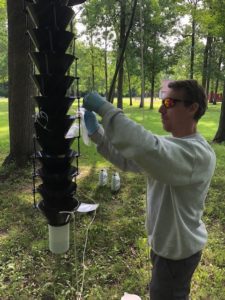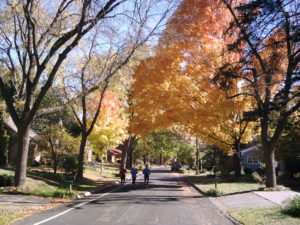By Mike Hillstrom, forest health specialist, Fitchburg. Michael.Hillstrom@wisconsin.gov; 608-513-7690
The Wisconsin DNR’s forest health team received funding to trap for non-native beetles in 2018. This project was funded by the US Forest Service through an Early Detection and Rapid Response (EDRR) grant. The project is complete, and we happily share that we did not find any non-native beetles!

Forest health staff member Scott Schumacher hangs a Lindgren funnel trap to survey for non-native beetles.
The Forest Service periodically provides funding to states to trap for non-native bark and ambrosia beetles. The goal of trapping is to detect, delimit and monitor newly introduced exotic beetles and to quickly assess and respond to newly detected infestations.
We placed traps at 12 high-risk sites in Jefferson, Waukesha, Milwaukee, Racine, Manitowoc, and Brown counties. Sites were selected in collaboration with the Wisconsin Department of Agriculture, Trade and Consumer Protection and were based on proximity to large commercial port entries on Lake Michigan or recycling facilities for pallets and other waste packaging. Three Lindgren funnel traps (12 funnels stacked to look like a tree trunk) and lures were assembled at each site and checked every two weeks between early May and early August. Specimens collected from the traps were sent to a Forest Service taxonomist for identification.

 Not every city in Wisconsin has a municipal code or ordinance that includes trees, and even then, those that do have codes may not have forest-friendly ones. A new resource has been created and has taken care of the hard work of determining if your city’s codes are forest-friendly; and if they are not, the resource provides advice on how trees can be more welcome in your neighborhoods.
Not every city in Wisconsin has a municipal code or ordinance that includes trees, and even then, those that do have codes may not have forest-friendly ones. A new resource has been created and has taken care of the hard work of determining if your city’s codes are forest-friendly; and if they are not, the resource provides advice on how trees can be more welcome in your neighborhoods. 